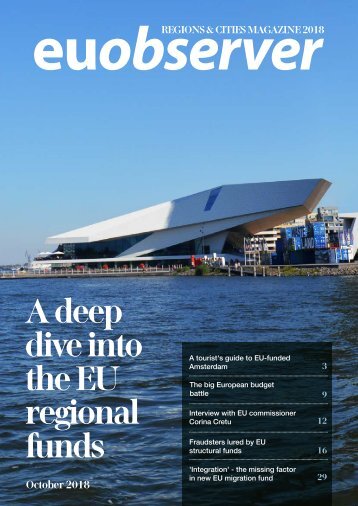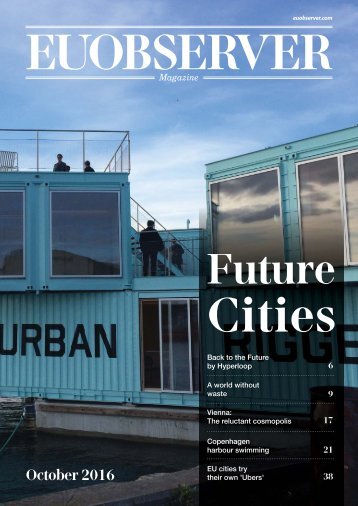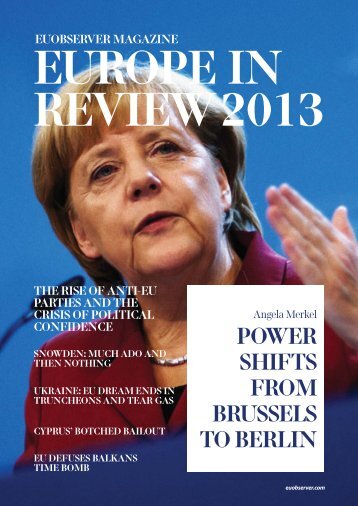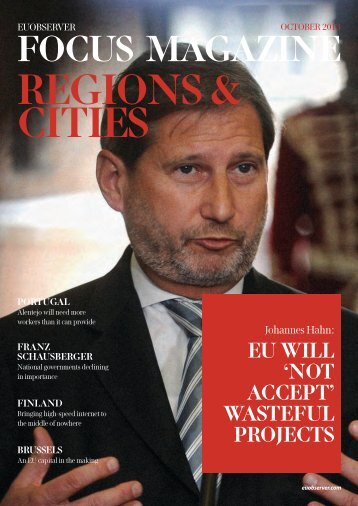Regions & Cities 2013: Cohesion Policy and Regional Aid
- Text
- Enlargement
- Finland
- Regions
- Portugal
- Artic
- Hahn
- Aid
- Policy
- Regions
- Cities
- Brussels
If yOU BUILD IT, wILL
If yOU BUILD IT, wILL THEy COME? As EU-backed projects go, the hydroelectric Al-Queva dam in the Alentejo region of Portugal looks mighty impressive. By: Benjamin Fox he hydroelectric Al-Queva dam in Portugal looks mighty impressive. T The dam was initially opened in 2002 with the help of €203 million of EU funding, and currently has a capacity of 259 megawatts. The second stage of development, with an additional 259 megawatts, was commissioned earlier this year. In the process, the dam also created the largest artificial lake in Europe, providing enough water supply for the region’s farming communities to survive three years of drought. Such projects are the “anchor of development,” says Jorge Pulido Valente, the mayor of nearby Beja, a city of around 50,000, which sits in the Alentejo region of Portugal, just under 200 kilometres southeast of Lisbon. The city played host to the Congress of European Emerging Regions (CoEER) in September, with the underlying theme the role of infrastructure projects in driving regional economic growth. The Al-Queva dam, together with the development of Sines harbour just over 50km away, and Beja international airport, a converted military airbase, are the jewels in the region’s crown. With Portugal in recession as it struggles to cope with an economic crisis which forced it into a €90 billion bailout programme in 2011, getting the most out of the country’s EU structural funds is now a political priority. It is also an issue which unites local politicians. Government-created regional assemblies bring together local mayors who then draft a programme on how the largesse from Brussels should be spent. The next big project is likely to be an irrigation system capable of treating water and sewage for 21 municipalities in the region. A strong case can be made that big public investment projects can act as stimulus measures, giving a shot in the arm to the region affected. Hundreds of jobs are created at the construction phase and, barring very poor planning, the economic gains will see a relatively speedy return on the investment. A study to analyse the effects on population growth and jobs estimates that 20,000 people will come to Beja and its surrounding area due to the new job prospects, particularly in the agriculture sector. Unemployment in the Alentejo region stands at 11 percent and falling, much lower than the national jobless rate of 17 percent and rising. “We will need more workers than the region can provide,” the mayor says. Portugal will get a total of €19.6 billion in EU structural and cohesion funds in the 2014-2020 budget cycle, much lower than the €21.5 billion available to it between 2007-2013. One billion euros has been specifically allocated to help with the country’s economic difficulties. But one of the consequences of the crisis is a greater number of applicant projects competing for a smaller pot of money. “We now have three important projects that are candidates for EU funds but only one will be selected,” Pulido Valente comments, adding that “the problem is not the amount of funds but the national and regional priorities.” It seems that the Alentejo experience is, to paraphrase a famous line from the Hollywood film Field of Dreams: “if you build it, they will come”. It is not quite that simple, however. Agriculture, and in particular, olives and grapes, is the main source of income in the region, and the sector is growing. However, projects such as Al-Queva and Sines harbour offer job opportunities that encourage migration from rural communities. But EU resources are needed for rural communities, says Pulido Valente, noting that over 60 percent of the Portuguese population live outside the country’s cities. EU regional policy is “almost exclusively aimed at competitiveness in urban areas, but we need funds to support projects in rural areas.” 8 OCTOBER 2013 REGIONS & CITIES
OCTOBER 2013 REGIONS & CITIES 9
- Page 1 and 2: EUOBSERVER OCTOBER 2013 FOCUS MAGAZ
- Page 3 and 4: OCTOBER 2013 REGIONS & CITIES 3 Eur
- Page 5 and 6: A s Anne-Mari Leppinen tells it, he
- Page 7: Assembly of European Regions Youth
- Page 11 and 12: Some general facts about theRepubli
- Page 13 and 14: ARCTIC REGION TO SEE GREATER FOCUS
- Page 15 and 16: But urban planners are working - al
- Page 17 and 18: EU COHESION pOLICy: ‘No MORE BUSI
- Page 19 and 20: The Regional Research and Innovatio
Inappropriate
Loading...
Mail this publication
Loading...
Embed
Loading...





















